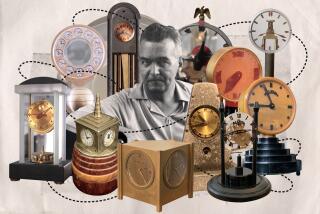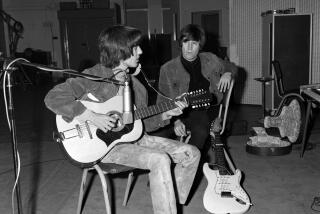A Laguna Beach craftsman has a passion for clocks
Dean Armentrout’s problem clocks keep him awake at night. Some run fast. Some run slow, and some don’t run at all. Repairs often mean cleaning and oiling the mechanism; balky escapements, missing parts and hidden friction points are trickier.
Each day, walking into his shop in Laguna Beach, Armentrout sees his workbench cluttered with tools and the pieces of jobs he hasn’t finished or figured out. In his hands, a clock is not so much an instrument for measuring time as a puzzle to be solved.
Surrounding him are nearly 50 of his favorite puzzles. Half belong to his customers, and the rest are his, each a reminder of what’s at stake with every repair.
“A clock that doesn’t run is a clock that will be thrown out,” he says.
He picks up a 19th century French clock that’s been giving him trouble. Its lavish setting on a nearby table features the gilded figures of Cupid and Psyche playfully jostling over a garland as if time were incidental to the pleasures of life.
Its owners, Rich and Karin Schag, bought it in 1968 while on vacation in Copenhagen. They’d just begun collecting clocks and saw it in the window of a jewelry store. When they got it home, they set it up on the sideboard in their dining room.
Today the Schags have nearly 100 clocks, but when this one stopped running in January, the silence of its chime was conspicuous, said Karin, 74.
The timepiece itself is six inches in diameter, four inches thick. With its face and hands removed, it gleams from Armentrout’s cleaning, but its wheels and arbors are motionless, the pendulum silent.
All it takes to break a clock, Armentrout says, is a little dust drying out the drops of oil at every pivot hole. Friction builds with each tick and tock. The minute hand drags and stops, and decades later, if not centuries, the clock ends up in the attic or garage.
In this case, he suspects a home repair gone awry. He bends a small brass arm that’s shaped like a broad V and repositions it in contact with a wheel. The clock is still silent. He tries again, bending it a little more. Nothing.
Armentrout has been repairing clocks for almost 40 years, and as the 21st century grows brighter in its electric and digital brilliance, he has watched as his profession grows smaller, his skills rarer and mechanical clocks — timepieces that run without batteries or electricity — less valued.
One clock, an 1880 walnut parlor clock, was left on his doorstep in a cardboard box, without a note of explanation. Another, made by Seth Thomas and worth $1,500, was brought in by a customer who paid $10 for it at a garage sale. Another, from the 1890s with art nouveau woodwork, was given to him.
Once he gets them ticking, he says, it’s like hearing a long-silent heart beating again.
::
Armentrout wonders where the next generation of clockmakers will come from. He has trained three apprentices and learned that they have left the business.
In the United States, there are only two schools that offer comprehensive clock repair programs, said Steve Humphrey, executive director of the National Assn. of Watch and Clock Collectors. Humphrey estimates that in the 1960s, there were at least 40 schools teaching clock repair.
Armentrout, 60, finds himself busier than ever. His customers come to him through referrals, street signage and his website.
“Dean stands out in a trade where almost all of those practicing have little or no formal training,” says David Walter, an award-winning clockmaker who lives in Buellton, Calif. “He works on some of the most modest clocks and some of the most sophisticated and knows to ask questions when faced with a problem he can’t solve.”
Armentrout’s workshop — part museum, part retreat — is in Laguna Canyon, where neighbors include a glass blower, a book binder and a furniture maker. He has 800 square feet, crowded with counters, work benches, machinery and clocks of all kinds.
Hall clocks, also known as grandfather clocks, strike august poses with the broad sweep of their pendulums and their painted faces. Gilt figures pose above dials of his French mantel clocks, and the English table clocks look like tabernacles, fit for an altar.
Others are strictly utilitarian, faces large and bells loud; a few are whimsical. Three caravels rock upon the sea in tandem with the pendulum of an 1820 Dutch wall clock, and an 1870 French clock — known as a mystery clock — features a pendulum, seemingly removed from the mechanism, swinging hypnotically from a woman’s outstretched arm.
“It’s amazing the amount of mechanical genius out there,” Armentrout says, then corrects himself, “was out there.”
One of his oldest timepieces is a 300-year-old pocket watch from England. A little smaller than a baseball, it was the most sophisticated timepiece of its era, perhaps the most sophisticated technology of its day. Under magnification, arabesques carved and engraved on each open surface enhance the interplay of its springs and wheels.
The grandfather clock that belonged to Armentrout’s grandparents stands to the right of the front door, a daily reminder of the memories these timepieces evoke. As a child spending the night in their Maryland home, he would listen to its chimes on the quarter hour coming up from the bottom of the stairs.
Sentiment is good for business. A clock’s steady cadence anchors the memories of customers who don’t seem to mind spending $600 on a timepiece that would sell on eBay for $200.
Once when he struck a bell inside a clock that he was about to fix, its owner started to cry. She hadn’t heard that sound since her mother’s death.
::
Armentrout was 22 when he first opened a clock. Even though he was daunted by its complexity, he was thrilled by the possibility of having found a career.
His parents had just divorced. He had moved from the East Coast to Laguna to be with his brother. He didn’t have a job, and his prospects looked dim. He’d received a tip from the youth employment office at a Catholic church about a job at Antique Clockworks on Coast Highway.
He never thought he would find work that combined his love of antiques with the pleasure of using his hands. He had enjoyed scouting second-hand stores for furniture and knickknacks with his mother back home in Maryland, where he had spent hours watching his father, a professional calligrapher, draw letters on paper.
He was soon making $2 an hour and moonlighting for an antiques dealer in Dana Point. Six years later, he and his wife sold everything — car, motorcycle, houseplants and bedding — and moved to England, where he enrolled in a trade college renowned for its yearlong program in antique clock restoration.
Since he returned, his work and life have taken a few detours. He sold antiques when the repair business slowed in the 1980s. He divorced, remarried and slowly built up his business. He estimates his annual income at almost $100,000.
His customers are used to pushing buttons, he says, and wonder what to do with the crank or the key that he hands them. They don’t know that these machines need periodic cleaning and oiling, and their children can’t always read an analog dial.
The age of the mechanical clock — considered by historians one of the greatest inventions in the history of mankind — is coming to an end, and Armentrout understands.
“There is no good reason to buy a mechanical clock,” he says, guessing that he has bought nearly 500. In his home, he keeps 35 clocks, 17 in his living room alone.
::
After 25 tries, Armentrout finds the correct angle for the V-shaped arm of the Schags’ clock. Its ticking joins the chorus in his shop. For the next two weeks, he will keep an eye on it, checking its time against his Swiss wristwatch and iPhone, and if it stays accurate, he’ll call the Schags to come get it.
His next project is an English table clock. Its case is black, most likely made of pear wood treated with pitch or ash. The steel hands have been pierced and blued, and surrounding the dial are gilt spandrels. But the mechanism needs cleaning and new bushings.
Its maker’s name, Thomas Hally, is engraved in script above the numeral 6 on the dial. Armentrout reflects upon Hally’s world — London in the 18th century — and turns over the back plate where, scratched into the brass, are the names of clockmakers who came before him.
F. Clark Leper, Sept. 1847.
“Lost to history,” he says, not knowing who Leper was.
Parkes, 8241.
“That would be Daniel Parkes,” he says, a famous clockmaker from London who worked on this clock on either Feb. 8 or Aug. 2, 1941, during or just after the Blitz.
C.R. Crookshank, 4-22-1977.
“A well-known repairman in Los Angeles whose shop was on Melrose Avenue.”
Some of the names are indecipherable, but it doesn’t matter to Armentrout. Who they are is less important than what they did; they kept the clock running for the next generation.
He has been thinking lately about his own legacy. He and his wife don’t have children, and he wonders how he will be remembered. He looks to his clocks.
In the corner of his shop hangs his first attempt to build one from raw stock, milled bars of brass and drill-rod steel. It doesn’t have a case, and he hasn’t finished the dial. It’s only a mechanism, the brass wheels, arms and pendulum moving in unison.
The oldest of five, he has decided to make each of his siblings a table clock, something that will continue to beat well after he’s gone.



